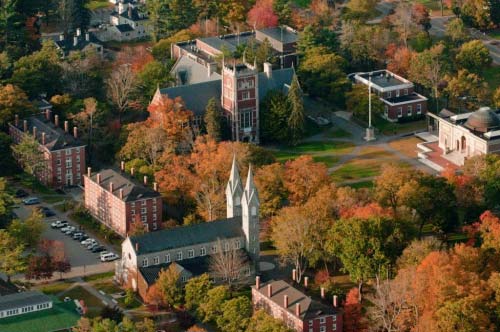































Bowdoin College is a liberal arts college based in the town of Brunswick, Maine. It houses 1839 students in about 100 buildings and offers 33 different majors and 4 minors. The Bowdoin IT Team are pioneering in nature as would be expected from the state whosemotto, "Dirigo", translates to "I lead"; adopting bleeding-edge best-in-class technologies to provide the optimal connected experience for students, faculty, staff and guests. This is counter-balanced with pragmatism in phasing the roll-out of these services.
This next generation pervasive WLAN network enables students to collaborate with each other anywhere on the campus and with the teachers in the classroom. In the previous blog in 2012, we described how Bowdoin upgraded to 3602 Access Points and used the innovative CleanAir technology tie-in with Event Driven Radio Resource Monitoring to optimize WLAN coverage. They also adopted the Cisco Prime and ISE 1.2 for manageability and consistent wired-wireless Policy respectively. In this blog, we will cover more details about the recent upgrade of the Wireless LAN Controller from the previous model WiSM to the new model 5760 and describe highlights of our conversation with Jason and Trevor about the WLAN deployment itself.

At a Glance:
Located in: Maine town of Brunswick
Number of students: 1839
Number of teachers/staff: 1000
WLAN clients 3100
3602 Access-Points: 500
Catalyst 3850 switches: 400
5760 WLC Controllers: 3 (Version 3.3.1)
Prime Infrastructure 2.0
Identify Services Engine 1.2
Mobility Services Engine
The two 5760 controllers are deployed in the DataCenter to manage the production network and a third is installed in a lab environment to experiment with the latest software releases including access to pre-released software for evaluation and to partner with Cisco for feedback. Four 10Gbe uplinks on the production controllers are used to provide connectivity to the Access Points.
Deployment Details:
A total of four SSIDs are deployed in the Bowdoin WLAN environment.

The Bowdoin WLAN network supports NO SSID Outage implemented via the Access Point Stateful SwitchOver feature. In this scenario, the standby 5760 continuously synchronizes Access Point states with the primary controller thereby allowing sub-second fail-over in the eventuality of the crash of a primary controller.
Where do we go from here ?
We talked to Jason Lavoie, the Director of Networking and Telecommunications and Trevor Jennings, an Associate Network Engineer to discuss some of their thoughts around their choice of this solution and the associated benefits.
 Tags quentes :
Cisco Services
#Educação
higher education
IT
implantação
cleanair
college
bowdoin
IPv6 in WLAN
Tags quentes :
Cisco Services
#Educação
higher education
IT
implantação
cleanair
college
bowdoin
IPv6 in WLAN